The HP S700 And S700 Pro SSD Review
by Billy Tallis on September 7, 2017 9:00 AM ESTSequential Read Performance
Our first test of sequential read performance uses short bursts of 128MB, issued as 128kB operations with no queuing. The test averages performance across eight bursts for a total of 1GB of data transferred from a drive containing 16GB of data. Between each burst the drive is given enough idle time to keep the overall duty cycle at 20%.
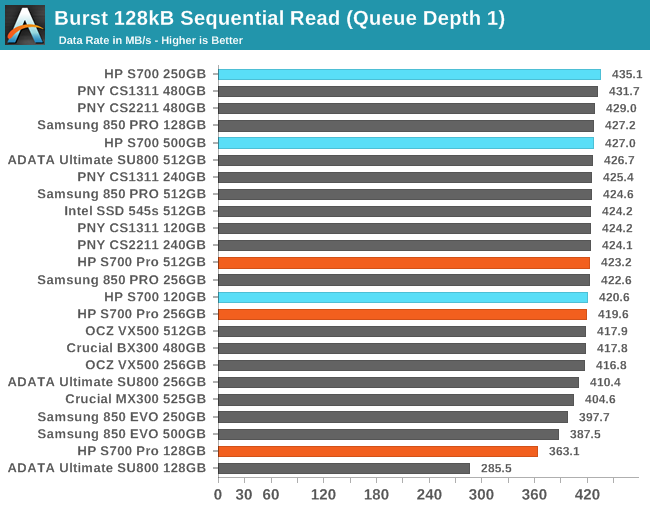
The S700 and the larger two S700 Pros have great burst sequential read speeds, while the smallest S700 Pro has a bit of trouble (but still manages to outperform the smallest ADATA SU800 by 27%).
Our test of sustained sequential reads uses queue depths from 1 to 32, with the performance and power scores computed as the average of QD1, QD2 and QD4. Each queue depth is tested for up to one minute or 32GB transferred, from a drive containing 64GB of data.
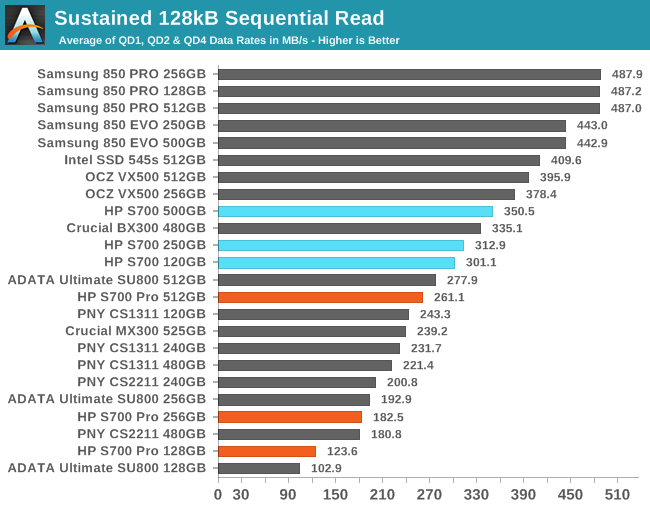
On the longer sequential read test, the S700 doesn't drop to the bottom of the chart and instead offers above-average performance. The S700 actually has the fastest low queue depth sequential read speeds of any SATA SSD with Micron's 32L 3D NAND, including the MLC-based Crucial BX300. The S700 Pro is far slower and only its 128GB model beats the comparable ADATA SU800. We've asked HP if they can shed some light on how the S700 manages to deliver such an outstanding sequential read speed, because this is a very surprising result.

With good performance by TLC standards combined with the low power draw of a DRAMless Silicon Motion controller, the HP S700's power efficiency during sequential reads is great. The S700 Pro is near the bottom of the chart, but is a clear improvement over the ADATA SU800.
 |
|||||||||
Only a few drives have trouble delivering full performance for sequential accesses at QD1, and the HPs aren't on that list. The S700's performance is both higher and more stable across the test than the S700 Pro.
Sequential Write Performance
Our test of sequential write burst performance is structured identically to the sequential read burst performance test save for the direction of the data transfer. Each burst writes 128MB as 128kB operations issued at QD1, for a total of 1GB of data written to a drive containing 16GB of data.
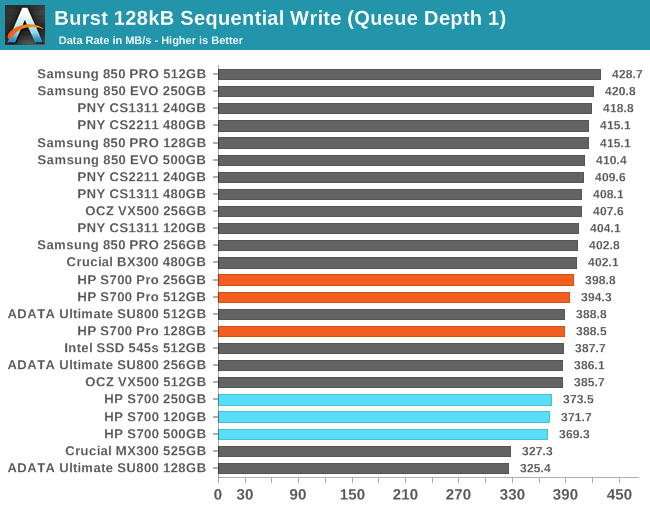
The HP S700 is just a bit slower than average for burst sequential write speed, and the S700 Pro is right around the average. The Crucial MX300 and the smallest ADATA SU800 are the only real outliers on this test.
Our test of sustained sequential writes is structured identically to our sustained sequential read test, save for the direction of the data transfers. Queue depths range from 1 to 32 and each queue depth is tested for up to one minute or 32GB, followed by up to one minute of idle time for the drive to cool off and perform garbage collection. The test is confined to a 64GB span of the drive.
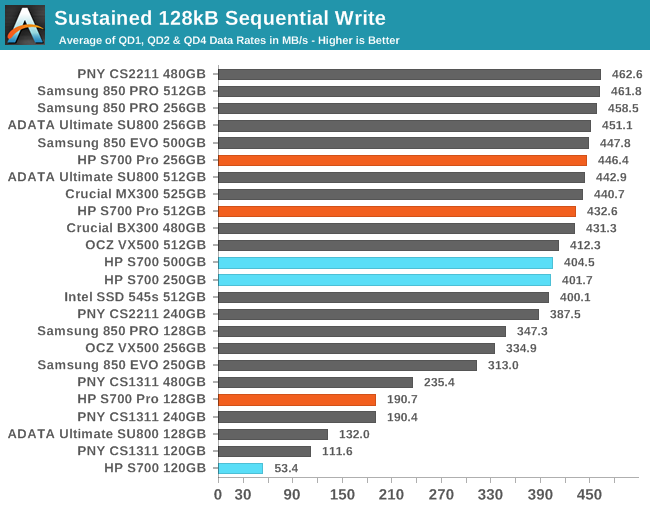
The longer sequential write test shows that the 120/128GB class drives are at a significant disadvantage, but the S700 Pro performs well among that cohort. The larger S700 and S700 Pro drives all offer decent sustained sequential write speeds and rank quite a bit higher than for the shorter sequential write test.
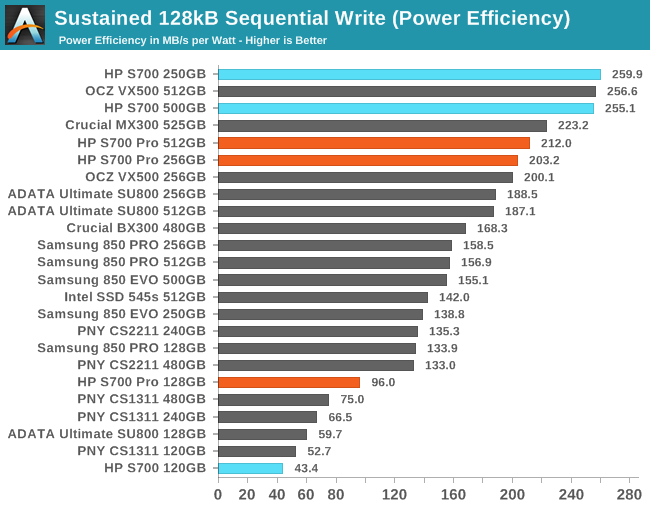
The larger two S700s join the OCZ VX500 at the top of the efficiency chart for sequential writes, and the larger S700 Pros aren't far behind. The smallest S700 Pro is far less efficient than its larger siblings, but offers 60% higher performance per watt than the ADATA SU800 and is in the top of its class (again, not counting the discontinued Samsung drives). The 120GB S700 has the lowest efficiency.
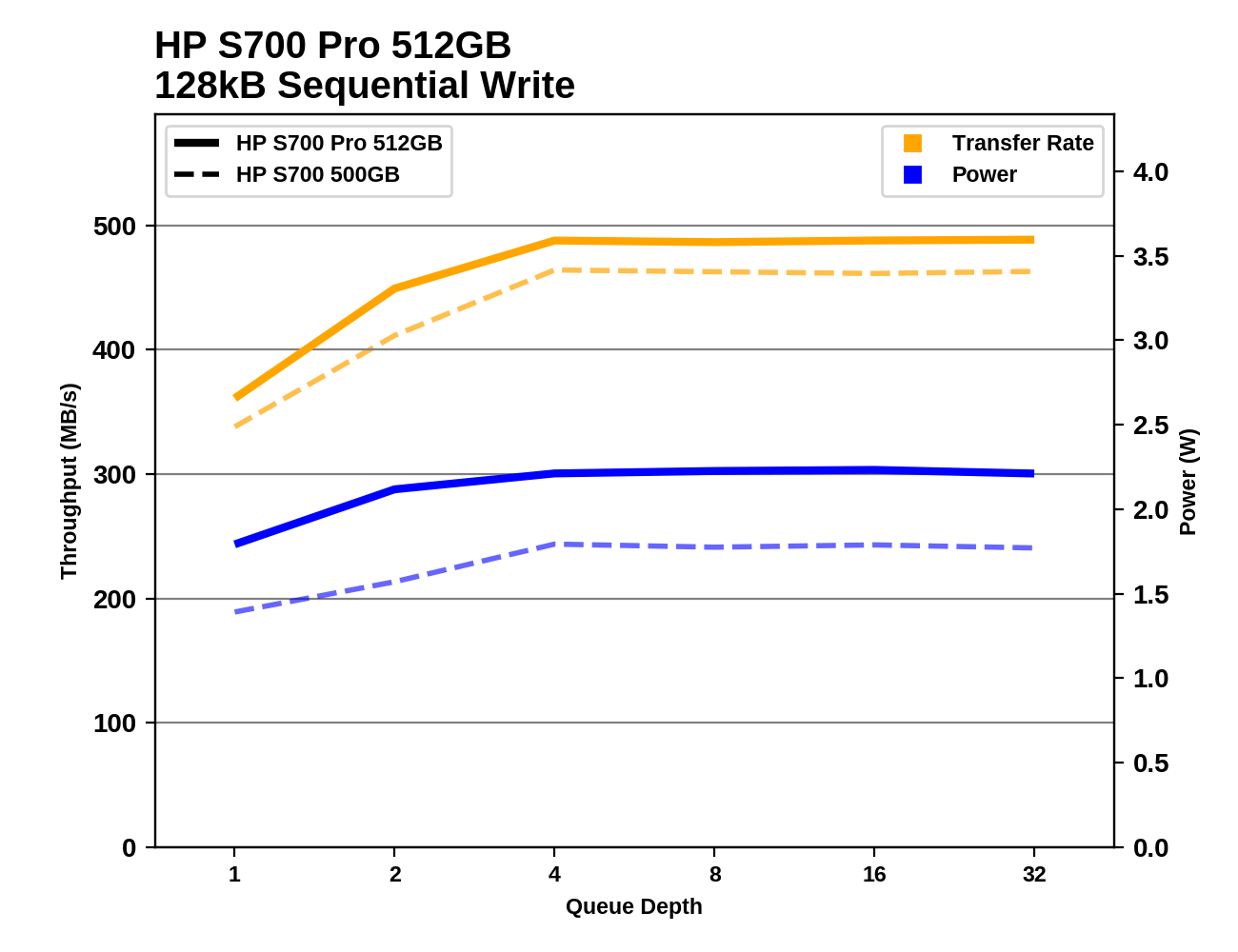 |
|||||||||
The 500/512GB HP drives and the 250GB HP S700 don't saturate until QD4, while the 256GB S700 Pro manages to saturate at QD2. The 128GB S700 Pro runs out of spare area while the test is at QD2, so it never comes close to sustaining a speed that saturates the SATA link. The 120GB S700's performance is relatively consistent and increases somewhat with queue depth, but is overall still quite slow.










54 Comments
View All Comments
ddriver - Thursday, September 7, 2017 - link
Why is it "Pro"? Performance - nope, endurance - nope, warranty - nope, sounds better - nailed it.HP's brand new Pro bested by Samsung's ancient Evo...
MajGenRelativity - Thursday, September 7, 2017 - link
It's better than the 700 non-Pro, so it warrants that in relation to its other counterpart.mooninite - Thursday, September 7, 2017 - link
You nailed it. Unfortunately HP will sell units because 1) they'll ship them in their own systems they sell and 2) they have blindly loyal customers.MajGenRelativity - Thursday, September 7, 2017 - link
I assume that's why HP went to the trouble of making an SSD? :Psyxbit - Thursday, September 7, 2017 - link
Making? They're not making anything here. They're repackaging another company's engineering efforts.Samus - Thursday, September 7, 2017 - link
The only blindly loyal customers out there are Lenovo's. On the whole, HP's mid-high end systems are the best on the market. Both companies...all companies, make crap at the low end. The business and professional market are where HP just destroys Lenovo is serviceability, reliability, and support. Lenovo simply wins on price. That's why people love them. Because they are cheap. And orange.sonny73n - Friday, September 8, 2017 - link
You sound spiteful. Are you hurt because Lenovo took over as the world's top ranking PC manufacturer after Q2 2013? HP has only gone downhill after that because all HP products have been made in China since who knows when.There's no company I dislike more than a domestic one with products being made overseas then shipped back and sold at home.
barleyguy - Friday, September 8, 2017 - link
You can't have your cake and eat it too. The reality is that western labor costs about 10 times as much as Chinese labor, and it's a price competitive market. If an HP laptop was built domestically, it would cost hundreds of dollars more, and most people would buy the cheaper one built in China.You either get cheap electronics or you get domestic manufacturing. At this point in time, you can't have both.
FunBunny2 - Friday, September 8, 2017 - link
-- The reality is that western labor costs about 10 times as much as Chinese laborthat made a bunch of difference years ago, but if you look at the FRED data, labor has become a vanishingly small part of production cost. if you're relying on bleeding labor to make money, you won't make much money.
Alexvrb - Sunday, September 10, 2017 - link
Exactly. Also there are lots of regions of the US where labor is cheap (rural low cost of living parts of RTW states for example). I suspect other factors such as taxes and regulation drive them to move production overseas more so than the hourly rate of workers.